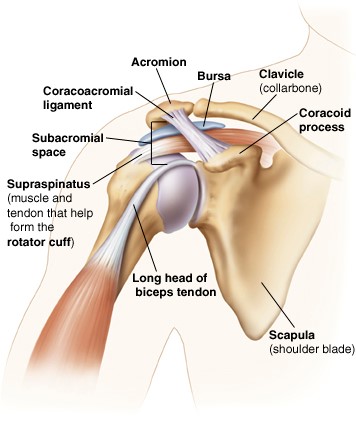What is shoulder impingement?
Jun 01, 2020
Shoulder impingement syndrome is a generalized term to refer to pain and pathology due to compression of tendons and soft tissue in the shoulder region.
Most commonly the diagnosis is referring to subacromial impingement where the space between the acromion and the humeral head is narrowed (see picture below). This frequently entraps tendons of the rotator cuff muscles (particularly supraspinatus and infraspinatus) and/or the long head of the biceps brachii. Typically, you will have pain with lifting your arm either in front or to the side, particularly in the mid-range of that movement. Another provocative position being: arm lifted to 90 degrees, reaching across to opposite shoulder and then lifting the elbow higher than the shoulder. It may be painful to lie on that shoulder. Sometimes weakness or decrease in the arm movement can occur as well. There are two major types of impingement: external and internal.
| External
| Internal
|
Conservative intervention is the recommended treatment. If initiated early, tearing of the tendons may be avoided. The focus of treatment will be on both mobility and strength/stability. There are several joints in the shoulder region, your provider will likely perform mobilization techniques to maintain normal movement of these joints. We will also focus on the range of motion in your shoulder. Not only the ability to lift to normal heights, but focusing on the quality and efficiency of the arm and scapular movements. Lastly, we must restore strength and stability. Activities will involve scapular stabilization, isometrics and activity specific exercises.
Check out this *****video***** for some workout do’s and don’ts regarding shoulder impingement.
Subscribe to our YouTube channel or follow us on Facebook and Instagram for more videos, tips and information!
